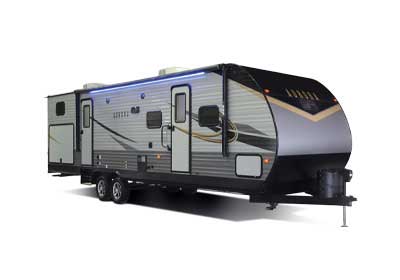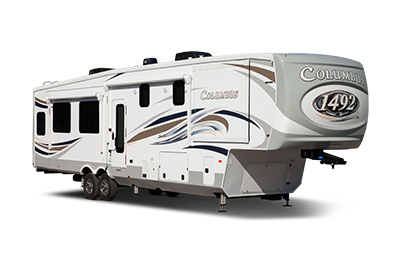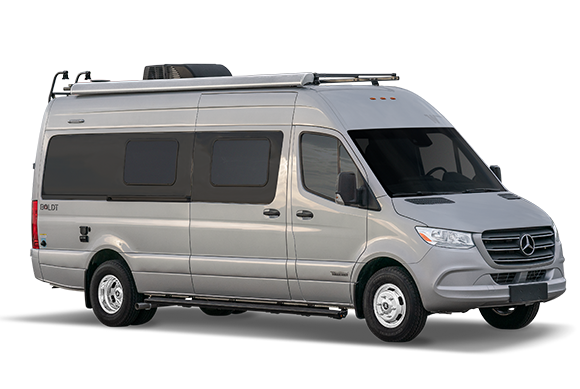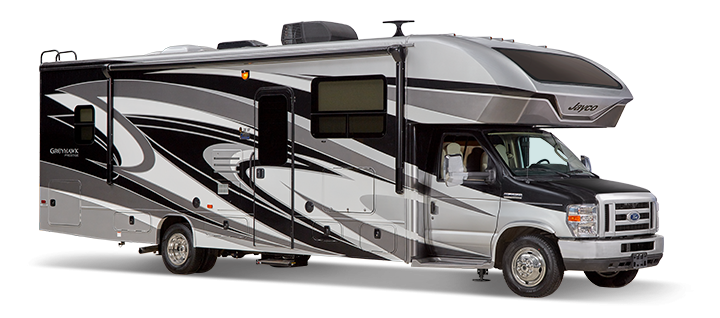Thinking about a new or used RV? When starting the process of purchasing an RV, there are a lot of things to consider, such as brand, floor plan, style, and type. For these reasons, it’s good to have an idea of the type of RV you’re interested in before showing up at your local RV dealerships. So while hearing terms like towable, motorized, and the fifth wheel may start your head spinning, don’t worry; it is pretty normal.
First, take a deep breath and keep reading. We are here to make this as painless as possible. Second, it’s time to understand the various RVs available to help narrow down the search. Finally, by the time you reach the local RV dealership, you should have a solid understanding of what you are looking for so the salesperson can help you find the perfect RV. Now, get comfortable and prepare to learn the basics about the 5 types of RVs available.
Towables
1. Travel trailers

Travel trailers are known by several names, including towables and TT. These are the most popular of all the types of RVs and range from small teardrops and pop-up campers to large travel trailers. Smaller campers typically do not have bathroom facilities and will be the lowest cost of entry. Larger towables offer more amenities, with some models featuring two bathrooms and a bunkhouse in addition to the master bedroom. In other words, there are many options available that allow families of up to 10 people to sleep comfortably.
Before setting out for a towable, check the towing limits for your vehicle. For example, consult the owner’s manual, or when in doubt, call your car dealership and ask. Based on your vehicle towing limits, this will help you narrow down right away the max size (i.e., weight) towable you can consider.
Price: Starting prices vary by type and size, but typical entry can be as low as a few thousand dollars all the way up to the most deluxe models topping out around $80k.
Pros: Lowest cost of entry compared to other types of RVs. A large selection of floor plans and layouts to choose from with a variety of manufacturers.
Cons: Towing anything, especially larger trailers, will require a truck or SUV. Backing up can be difficult, especially for new owners. These units can also be unstable in high winds.
2. Fifth Wheel

The largest of the towable campers are fifth wheels. These require a large truck, preferably diesel, to haul and a special mount (aka hitch) to be installed in the bed of a truck. Towing a fifth wheel is typically easier and more stable than a standard ball hitch utilized by all other towables.
Many of the fifth wheel campers have slide-outs making this class of RV very spacious. These are an excellent choice for large families or those traveling with large groups. In addition, several manufacturers offer a toy hauler plan so you can easily load a golf cart, off-road vehicles, kayaks, motorcycles, and other toys into the back of the RV. If you select a toy hauler, be sure to calculate the camper’s total weight with everything loaded inside. Most importantly, ensure it doesn’t exceed the towing capacity of your truck.
Price: Ranges from $25k all the way up to $100k or so.
Pros: Large and spacious floorplans with lots of amenities and options.
Cons: Must have a large truck to pull a fifth wheel, and the hitch mount setup takes up the truck bed and is not easily removed when not using the camper.
Towable Recap
Towables and fifth wheels are the two most common RVs. They have a large variety of models, floorplans, options, and price points. In other words, something for every budget and lifestyle. Both require a vehicle large enough to tow and offer many options for families of all sizes.
Keep in mind that these types of RVs typically do no have generators pre-installed. Therefore, you won’t be able to cool down (or warm-up) the inside until settled in a campsite and hooked up to shore power. Therefore, if you plan to boondock, you will need to add a generator or carry a portable one with enough power for the unit.
People and animals should NEVER travel in the trailer. This seems pretty self-explanatory for safety reasons. But, surprisingly, people make a mistake every year and regret it.
Driveable
The next classes of RVs are motorized or driveable units. There are three types of RV in the class, varying in size, amenities, and price points. Each type has its own distinguished style.
3. Class B Motorhome

Class B is the entry-level of the drivable RV class, as well as the smallest. It also goes by the name B-Vans or camper vans. This class is a great way to get behind the wheel and not be overwhelmed with the size of the vehicle and still be in a self-contained unit that you can sleep and cook inside.
Class B vans come in several sizes and floor plan options and are offered by some major RV manufacturers. Built on a van chassis, Class B vans come in gas or diesel options and are easy to drive. This class is a favorite among solo travelers and couples as it perfectly transitions from city driving to adventures off-road or off the beaten path. Because of the smaller size, there is a lot less storage space. The kitchen area typically consists of a small refrigerator and cooktop. Some models do offer a microwave as well.
Being off the grid for any length of time would be difficult in this class, but the smaller size means you can drive and park just about anywhere.
Price: $100k to $250k depending on size and options.
Pros: Compact and easy to drive and park as they fit in any normal space.
Cons: Limited storage and space overall, and the bathrooms are more of a wet room with a sink, toilet, and handheld shower.
4. Class C Motorhome

The next size up is the Class C motorhome built on truck chassis, making them pretty easy to drive. Like any RV, you always need to make sure you are mindful of the extra height and length. Class C comes in gas or diesel options.
Class C motorhomes range in size from the smallest at about 21 feet in length all the way up to the Super C, which max out about 41 feet. Depending on the floor plan, you can sleep anywhere from four to eight people. While the floorplans will vary, you will always find a bathroom, kitchen, and a slide-out or two, making it feel more spacious when parked.
Class C is at a more budget-friendly price point on a smaller scale than the larger Class A. Great for couples and families of all sizes, Class C motorhomes will give you room to spread out and the ability to stay off the grid for a night or two. There is truly something for everyone in this class of RV.
Price: Ranges between $50k to $100k, with the Super C starting around $100k all the way up to $300k.
Pros: A large variety of floorplans, options, and sizes for new and experienced RVers.
Cons: Limited storage for larger families may require more planning for those wanting to take extended vacations.
5. Class A Motorhome

The mac daddy of the RV kingdom is the Class A Motorhome and comes in gas and diesel options. Class A comes in various lengths ranging from about 26 feet long all the way up to 45 feet, with these longer coaches having a third or tag axle. In addition, there are a variety of floor plans and options that are well suited for couples or families looking for weekend getaways all the way up to full-time living.
All Class A coaches feature at least one bathroom, with some models offering a bath and a half or two full bathrooms. Additionally, the kitchen typically features a residential size refrigerator, cooktop, microwave, and optional dishwasher. Further amenities include seating, TVs, and plenty of storage and living space. Class A can have anywhere from one to four slides making it feel even larger. Basically, you will find all the conveniences of home on a Class A motorhome.
Gas vs Diesel
The diesel is often referred to as a diesel pusher because, simply put, a diesel engine pushes its cargo where a gas engine pulls. The average layperson likely won’t know or care about this but in a motorhome. However, there are some significant differences worth noting and considering during the search process.
Diesel has its engine located in the back of the coach, which minimizes noise when driving. Conversely, a gas coach has the engine at the front, making it a little warmer (heat from the engine) and a noisier while traveling.
An additional consideration for gas versus diesel is if you plan to tow a vehicle, boat, or hauler behind the coach. While gas coaches can tow behind, it will need to be a small car or boat. Diesel coaches give you a lot more power (torque) to allow for towing something larger and heavier.
Price: Gas entry-level coaches start around $100k all the way up to the largest diesel topping out well over a million dollars and everything in between.
Pros: All the comforts of home, spacious and lots of storage making extended trips very easy.
Cons: The price tag, being the most expensive of all the RV types, can be a deterrent for some, and the overall size takes some practice to build confidence.
Related Article: How to Decide on Gas vs. Diesel Motorhome
Conclusion
Take your time, make a list of all the must-have features, and shop around. Prices can vary widely depending on the location and the economy of your local area. Check to see where the RV is manufactured, as many times dealerships close by will have lower prices due to reduced delivery costs. The longer the delivery distance, the higher the cost, and the dealership will pass that cost along at the time of purchase either has a line item cost or bundled into the purchase price.
Now that you have the lay of the land as far as RV classifications, it’s time to educate yourself on the various makes (aka brands) and models available. There is a list below of related articles to help you in the next steps. No matter what class of RV you decide, enjoy the freedom to vacation whenever the mood strikes. Happy camping!
